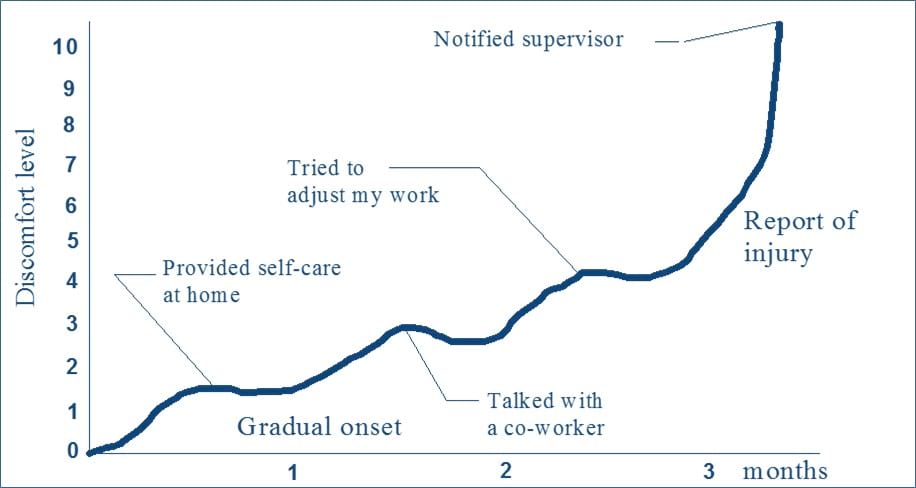Just how painful is injury reporting?

The reporting of injuries or health problems at work—especially sprains and strains—is a vexed issue.
On the one hand, if people delay reporting their injury there may be questions about whether the problem is really work related. For example, a twinge of pain might be felt one day and brushed off as no big deal. However the worker may choose to report the problem the next day, when the muscles tighten up and they have difficulty moving. Some employers misinterpret such situations and suspect that, in fact, the problem has developed at home.
On the other hand, 50% of the population has a long-term musculoskeletal problem. If people reported all problems whenever they played up, many workplaces would need a full-time person to deal with injury reports.
In everyday practice people tend to report injuries and other problems when the discomfort involved substantially interferes with work tasks.
Below is a graph produced by Liberty Mutual, examining how an employee with gradual onset musculoskeletal soreness deals with their problem.

It shows the typical pattern of symptoms—including rising levels of discomfort—and how the average person is likely to deal with the situation.
Initially, most people try to accommodate their problem, perhaps by modifying what they do or taking some pain tablets. As the problem becomes more of an issue they’ll discuss the condition with a co-worker, and finally when it becomes significant they’ll report it to their supervisor.
Of course this approach makes common sense. People know that companies are focused on productivity, and there is no use reporting things that aren’t of significance.
However, delays in injury reporting may mean that the opportunity for early intervention is lost.
There is no cure-all solution to the conundrum of injury reporting—but there are positive steps that can be taken.
The basic principles of best practice injury reporting are to:
- Ensure that people are comfortable reporting their problems;
- Deal with problems promptly, as they arise; and
- Encourage early reporting.
If a workplace discourages injury reporting they are likely to receive less reports: but it is also likely that the reports they do receive will be more difficult to resolve.
If a workplace encourages reporting and deals with these reports well they are likely to receive more reports but will also find solutions for a greater proportion of the problems raised.
Many workplaces, and in fact some state-based systems in the United States, can show wonderful graphs demonstrating a reduction in injury reports for lost time injuries, but at the same time an opposite trend in total work time lost. Injury reports or lost time injuries are not a valid assessment tool for looking at work disability management, despite the fact that they are used by many companies.
At the end of the day the juice of injury reporting is for the worker to know they’re going to be taken seriously, and for the supervisor to be confident about how they’re going to deal with the issue. A partnership that deals with the problem in a pragmatic and constructive way is the best way forward.

